Thanks to Warner Bros. and their star Errol Flynn, the early-1940s saw a resurgence of the swashbuckler subgenre across all of Hollywood. The United Artists production company found specific interest in the pirate stories of Captain Blood (1935) and The Sea Hawk (1940). Realizing they could frugally reuse many of their sets and props from Douglas Fairbanks’ earlier sea-based adventure films, United Artists put together the relatively low budget Captain Kidd. Directed by Rowland V. Lee, 1945’s Captain Kidd tells the story of a conniving pirate who assumes the role of an English captain to steal a ship from the British parliament. With the ship and his new alias, he recruits a crew of prisoners to assist him in stealing more treasure. The events depicted in the film are roughly based on the historical tales of real-life pirate, William Kidd. Still, there are quite a few historical inaccuracies to be found. Captain Kidd’s screenwriter Norman Reilly Raine was aware of these incongruities but decided to focus on retelling the overall legend of William Kidd and not the historical specifics. This is the same method he used when writing the screenplay for The Adventures of Robin Hood (1938). The use of morally unambiguous characters, comedic storytelling, and swashbuckling fight scenes within Captain Kidd epitomize the studio-era film industry’s common desire to create simple and fun adventure films during the ubiquitous bleakness of the second world war.
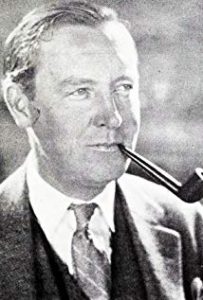
Rowland V Lee on the set of his adaptation of The Count of Monte Cristo.
One of the simplest, yet most effective, ways for an adventure film to convey its message is to have the antagonist act dishonorably while the protagonist fights for the principles that the creators believe is admirable. It takes less than thirty seconds after the opening credits finish for Captain Kidd’s writer to reveal to the audience that the titular character is anything but admirable. One of the first shots of the film is Kidd (Charles Laughton) standing proudly on a lifeboat in the foreground. He dwarfs all other characters on screen and his eyeline points down on them, revealing that he has all of the power in the scene. In the background of the shot, The Twelve Apostles (a ship that Kidd and his crew defeated) is lit ablaze. The ship’s name and Kidd’s destruction of it is a clear attempt to suggest Kidd’s wickedness through a Christian context. Adding to the religious undertones of the scene, a nondiegetic narrator reveals that Kidd has recently plundered another ship called The Virgin Mary. In the very next scene, Kidd sinfully betrays and kills his first mate to ensure he gets a larger portion of the treasure. Not only do these opening scenes eloquently reveal the tone of the film, but they also efficiently establish Captain Kidd as a reprehensible antagonist.
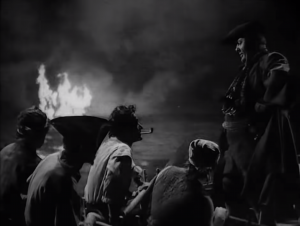
Captain Kidd gives off an aura of power within his first scene.
In direct contrast to the audience’s introduction to Kidd, Adam Mercy’s (Randolph Scott) first scene shows him to be a genuinely respectable character. Throughout the film, Kidd is mistakenly put in a position of power by the British government. This is precisely the opposite of what viewers see when they are introduced to Mercy. He is on death row in the royal prison for a crime that he didn’t commit. Also differing from Kidd’s introduction, the shot compositions show Mercy to be equal in size to those around him. Unlike Kidd, Mercy’s presence doesn’t command the frame. He doesn’t rise above others until later in the scene when he literally stands up for their rights. Ultimately, this towering stance isn’t one of contempt towards his peers, but respect. The differences in these introductory scenes are some of the many subtle ways that the film suggests Mercy as an antithesis to Kidd.
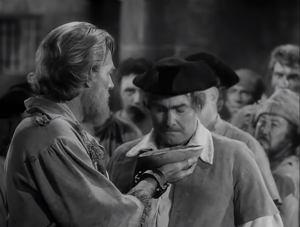
Adam Mercy stands up for his fellow prisoners.
Aside from the morally black and white character dynamics, another staple of the swashbuckling adventure film that Captain Kidd employs is the use of comedic elements. As Yvonne Tasker states in her book The Hollywood Action and Adventure Film, action films have often had comedy ingrained in their frameworks since the inception of genre during the silent era. Along with the greats like Buster Keaton and Charlie Chaplin, Tasker notes films featuring the Keystone Kops as being particularly influential for their use of comedy within chases and fight sequences. Captain Kidd continues the tradition of utilizing comedy to tell its adventure narrative. Most of the second act of the film plays with a series of comedic gags as Kidd tries to lie about his past, but Mercy (who has been recruited for Kidd’s crew) knows his secret. The film characterizes the protagonist and antagonists through vastly different forms of comedy which helps to further differentiate the two characters and their ideologies. The comedy revolving around Kidd is akin to traditional slapstick. He is featured in several scenes of physical farce as he tries to learn how to act like a proper English captain. Laughton’s comedic performance as Kidd was so widely praised that he would later reprise the role in the 1952 film Abbott and Costello Meet Captain Kidd (1952). Adam Mercy’s characteristics are painted with a different type of comedy. Rather than the classic comedic inspiration drawn for Kidd, Mercy was influenced by more contemporary performers like Errol Flynn. Mercy is quick-witted and charismatic with his humor. In one of the early scenes of combat Mercy spouts off several one-liners as he fights his opponent.
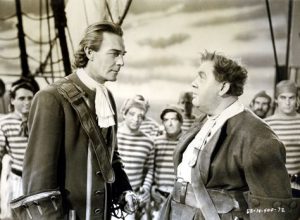
Mercy towers over Kidd as he makes him look like a fool.
The interplay that comes from the characters’ contradictory comedy styles is one of the places where the unwaveringly noble message of the film can be found. As Mercy dances linguistic laps around Captain Kidd and treats him like a stooge, the audience assumes that Mercy is an overall much smarter character. And, with every comedic failure the audience witnesses Kidd endure, they begin to associate his blatantly evil ideologies with those of an idiot.
Yet, even with all of the ideas mentioned above, perhaps the aspects of Captain Kidd that are the most emblematic of the mood of the Swashbuckler genre are the action scenes. While Captain Kidd has multiple genre tropes like over-the-top costumes, damsels in distress, and superimpositions of maps to denote a change in time and geographical space (à la Raiders of the Lost Ark), Tasker would likely argue that these aren’t what makes it a swashbuckler. Tasker notes that almost all historical adventure films of the studio era put a great emphasis on conflict and violence. Captain Kidd isn’t an exception. The film has three scenes of large-scale ship combat throughout it’s runtime. These were mostly produced with tiny miniatures, but a few scenes used 1:4 scale ships on a big lake to create a more natural look. The oceanic backgrounds when characters stand on sets made to look like ship decks were created with a combination of matte paintings and some double exposure effects. The more small-scale intimate moments of combat like the fencing battles and fist fights are all filmed on smaller sets to avoid having to implement these often-costly technical tricks during scenes with a shorter average shot length and a camera that moves more often. One of the most integral parts of the close combat scenes in Captain Kidd is the score. The Oscar nominated compositions feature quick woodwinds and snares to capture the energy and pacing of the sword-fights even when the contact of the swords is actually rarely in frame.
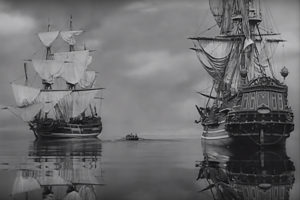
This shot with two ship miniatures makes some of the technical trickery obvious.
Finally, if the distinctions weren’t clear enough, the differences in how Mercy and Kidd approach combat also reveals key traits of each character. Mercy’s combat is always sleek and acrobatic. Lee directs the blocking of Mercy’s fight scenes to be full of childlike maneuvers around his environment. The combat encounters with him place a strong focus on the elegance of the male body. A few of Mercy’s combat scenes seemingly attempt to capture the same kind of youthful masculine energy that is found in the final prolonged sword-fight of The Adventures of Robin Hood (1938). Kidd, on the other hand, approaches combat in a much more nefarious way. Every single victory that Kidd finds in combat is only gained through deception. In one early scene, Kidd tricks a soldier into believing he’s never held a sword before, and then Kidd stabs the soldier after he’s let his guard down. This is drastically different from the longwinded but fair duels that Mercy has with his opponents. In most of the scenes where Kidd devilishly manipulates his opponents, the score contains a deep brassy trombone leitmotif which warns the audience of Kidd’s upcoming treachery. Unlike with Mercy, it’s never intended for any of Kidd’s combat achievements to feel earned in the eyes of the audience.
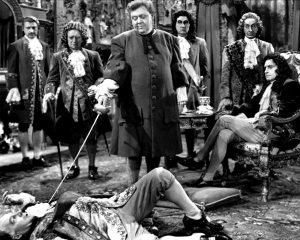
Captain Kidd stands over his defeated opponent after tricking him in a duel.
These small undeserved victories and overall defeat of Captain Kidd are what allow the valiant characteristics that Adam Mercy represents to truly prevail. In almost any action film, the physical conflict is the key determiner of what ideology the audience should admire. Captain Kidd’s message isn’t anywhere near as nuanced as later films such as Black Panther (2018), yet it’s still a message that was common for studio-era adventure films. During the bleak times of WWII, perhaps audiences naturally gravitated towards these lighthearted stories. Maybe the simple message of good beating evil in Captain Kidd took on a much deeper and desired meaning.
Adam Mercy fights a swashbuckling battle.

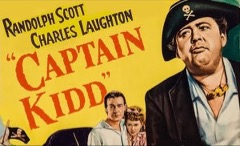
Trackbacks/Pingbacks